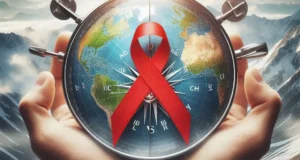Before the headlines. Before the panic. Before the virus even had a name—there was a moment. A quiet, almost imperceptible ripple in the vast ocean of human history. This moment is what scientists now call the Silent Zoonotic Shift—a whisper-like jump of a virus from animal to human that would one day roar into a global pandemic. And still, the question persists across continents and decades: AIDS—where did it come from?

To understand this silent shift, imagine a deep rainforest canopy, still and green, hiding more than just wildlife. Among the branches, chimpanzees swing freely, carrying with them a virus harmless to them but brimming with potential: SIV—Simian Immunodeficiency Virus. It has dwelled in them for millennia, co-evolving quietly, like a locked code waiting for the right sequence to awaken.
Enter the human hunter. A routine bushmeat hunt. A wounded animal, a bloodied knife, a cut on the hand. It is not an extraordinary moment. It is not marked in any book or remembered in any tale. And yet, this is the very doorway through which HIV first stepped into the human bloodstream. No alarm sounded. No fever erupted.
This is the heart of the Silent Zoonotic Shift—a species jump so subtle it evaded the gaze of science, medicine, and memory. Unlike outbreaks that announce themselves with dramatic symptoms, this viral transition slipped in like fog over the river. It is the quiet answer to the pressing question: AIDS—where did it come from?
For years, the virus may have lingered in isolated individuals, confined to small villages, passed unknowingly from one person to another. No tests. No diagnosis. No suspicion. This was the virus learning the map of the human body. Adapting. Evolving. Quietly becoming more efficient—more human.
The Silent Zoonotic Shift teaches us that pandemics do not always begin with explosions. Sometimes, they begin with a murmur. HIV didn’t arrive in the modern world overnight. It crept in, perhaps as early as the 1920s, moving invisibly through people who would never know they were carriers. And by the time urban centers like Kinshasa began to grow—with railways, trade, and crowded clinics—HIV had already secured its place in human history.

The question “AIDS where did it come from” is not just a matter of science, but of silence. It came from a quiet exchange between species. From blood and instinct. From survival and contact. It came not with fanfare, but with footsteps so soft they echoed only in retrospect.
What makes the Silent Zoonotic Shift so powerful as a concept is its metaphorical weight. It represents the idea that history’s most devastating forces often enter unnoticed. That danger, like a shadow, sometimes walks beside us long before we see it. HIV did not begin as a monster. It began as a stowaway.
Human intrusion into wild spaces, the hunting of primates, and the breakdown of traditional boundaries all contributed to that first, silent leap. And from it, the world inherited a virus that would alter millions of lives.
So the next time we ponder, “AIDS—where did it come from?”, let us look not for fireworks, but for the faint trail of footprints in the soil of forgotten forests. Let us remember the Silent Zoonotic Shift, and in it, the humility of knowing that not every danger shouts.




